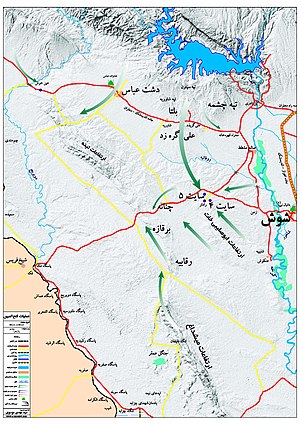|
Operation Fath ol-Mobin
Operation Fath-ol-Mobin (Persian: عملیات فتحالمبین, a Quranic phrase meaning "Undeniable Victory" or "Manifest Victory") was a major Iranian military operation conducted during the Iran–Iraq War, in March 1982 and resulted to the Battle of Shush. The operation was led by Lt. General Ali Sayad Shirazi and was conducted in four phases. Some believe that this operation was the turning point in the war[3][4] and that it led to the eviction of Iraqi troops from Khuzestan. Others (including Efraim Karsh) believe it was actually the operation working in tandem with others which led to the expulsion of Iraqi troops from southern Iran. He believes that in fact, Operation Beit ol-Moqaddas, which lasted from April to May 1982, had the greatest effect, because the Iranians were able to liberate the strategically important city of Khorramshahr. PreludeOn 22 September 1980, Saddam Hussein, attempting to copy the success of the Israeli pre-emptive air strike against the Arab air forces in the Six-Day War, launched numerous sorties against Iranian air fields, hoping to destroy the Iranian air force on the ground. Although they failed, Saddam was still not going to be prevented from achieving his aim of establishing complete Iraqi dominance over the Shatt al-Arab, called Arvand Rood in Iran (Persian: اروند رود) waterway. He launched a land invasion of Iran, focusing on southern Iran. He was able to achieve success, capturing the major Iranian city of Khorramshahr. Although the Iraqis were not able to capture the city of Abadan, the way was open to Tehran as the Iranian defenses had collapsed. The battleOn 22 March 1982, precisely 18 months to the day of the Iraqi invasion, the Iranians launched Operation Fath ol-Mobin. They intended to use a pincer movement to encircle Iraqi forces who had halted outside the Iranian town of Shush. Under the command of the young Iranian Chief-of-Staff, Lieutenant General Ali Sayad Shirazi, the Iranians launched an armored thrust on the night of the 22nd followed by constant human-wave attacks by Pasdaran and Basij brigades, each composed of about 1,000 fighters. The Iranian forces still had to contend with an Iraqi army which was entrenched on the front-line and they enjoyed a good amount of tank, artillery, and aerial support. The Iranians kept up the momentum against the Iraqi forces and, after heavy Iraqi losses, Saddam ordered a retreat on the 28th. AftermathAlong with Operation Tariq al-Qods and Operation Beit ol-Moqaddas, the Iranians were able to evict the Iraqi forces from southern Iran. The wider operation to re-capture Khuzestan is rightly to be considered a turning point. The Iranians had succeeded in achieving their standing aim of reversing the gains made by the Iraqi armed forces in the initial stages of the Iran-Iraq War. Afterward, the Iranian hardliners, headed by the Speaker of the Iranian Parliament Akbar Hashemi-Rafsanjani, argued for the expansion of Iranian war operations into Iraq. They eventually succeeded in getting their way, and the Iranians commenced several operations to conquer territory. But where the Iranians successfully used combined-arms operations to emerge victorious against the Iraqi troops in Iran, they relied upon unsupported human wave attacks by the poorly trained and lightly equipped troops of the Pasdaran and the Basij with an insufficient logistics capability. The Iraqis eventually stabilized their armed forces after their retreat from Iran. The result was that the Iranians would not be able to press their determined, but futile, assaults against a resurgent Iraqi army. Iraq was supported by both the United States and the Soviet Union who saw Saddam's regime as a much better option than Khomeini's regime.[5] UnitsIranKarbala Central Command
Source: [6] Iraq
References
Bibliography
|
||||||||||||||||||||||||||||||||||
Portal di Ensiklopedia Dunia
